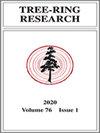A 307-YEAR TREE-RING SPEI RECONSTRUCTION INDICATES MODERN DROUGHT IN WESTERN NEPAL HIMALAYAS
IF 1.1
4区 农林科学
Q3 FORESTRY
引用次数: 21
Abstract
ABSTRACT Western Nepal has experienced a severe drought in the past two decades, but observation records across Nepal are too short to place the recent drought in a longer context to understand the full range of natural variability in the climate system. In the present study we have collected tree core samples of Tsuga dumosa from two sites, Chhetti and Ranghadi, in the Api Nampa Conservation Area of the western Nepal Himalayas to understand drought variation for the past three centuries. We have developed a 357-year (AD 1657–2013) tree-ring chronology. The tree growth-climate response analysis revealed a stronger positive correlation with spring (March-May) standardized precipitation evapotranspiration index (SPEI01) (r = 0.523, p < 0.01) than precipitation (r = 0.459, p < 0.01), self-calibrating Palmer drought severity index (scPDSI) (r = 0.250, p < 0.01), or temperature (r = -0.486, p < 0.01). Stronger positive correlation with SPEI01 indicates moisture availability is the limiting factor for the growth of this species on these sites. Based on this growth-climate response we reconstructed spring SPEI from AD 1707 to 2013 for the region. The reconstruction showed several dry and wet episodes indicating no persistent climate trend within the past three centuries. The current drought is one of the four most severe in our 307-year record.307年树龄的SPEI重建表明尼泊尔喜马拉雅西部的现代干旱
尼泊尔西部在过去二十年中经历了严重的干旱,但整个尼泊尔的观测记录太短,无法将最近的干旱置于更长的背景下,以了解气候系统中自然变率的全部范围。在目前的研究中,我们从尼泊尔西部喜马拉雅山脉的Api Nampa保护区的Chhetti和Ranghadi两个地点收集了Tsuga dumosa的树芯样本,以了解过去三个世纪的干旱变化。我们开发了357年(公元1657-2013年)的树木年轮年表。树木生长-气候响应分析显示,春季(3 - 5月)标准化降水蒸散指数(SPEI01) (r = 0.523, p < 0.01)与降水(r = 0.459, p < 0.01)、自校准Palmer干旱严重指数(r = 0.250, p < 0.01)和温度(r = -0.486, p < 0.01)呈正相关。与SPEI01有较强的正相关,表明水分有效性是该树种生长的限制因子。基于这种生长-气候响应,我们重建了该地区公元1707年至2013年的春季SPEI。重建显示了几次干湿交替,表明在过去的三个世纪里没有持续的气候趋势。目前的干旱是我国307年历史上最严重的四次干旱之一。
本文章由计算机程序翻译,如有差异,请以英文原文为准。
求助全文
约1分钟内获得全文
求助全文
来源期刊

Tree-Ring Research
农林科学-林学
CiteScore
2.40
自引率
12.50%
发文量
15
审稿时长
>36 weeks
期刊介绍:
Tree-Ring Research (TRR) is devoted to papers dealing with the growth rings of trees and the applications of tree-ring research in a wide variety of fields, including but not limited to archaeology, geology, ecology, hydrology, climatology, forestry, and botany. Papers involving research results, new techniques of data acquisition or analysis, and regional or subject-oriented reviews or syntheses are considered for publication.
Scientific papers usually fall into two main categories. Articles should not exceed 5000 words, or approximately 20 double-spaced typewritten pages, including tables, references, and an abstract of 200 words or fewer. All manuscripts submitted as Articles are reviewed by at least two referees. Research Reports, which are usually reviewed by at least one outside referee, should not exceed 1500 words or include more than two figures. Research Reports address technical developments, describe well-documented but preliminary research results, or present findings for which the Article format is not appropriate. Book or monograph Reviews of 500 words or less are also considered. Other categories of papers are occasionally published. All papers are published only in English. Abstracts of the Articles or Reports may be printed in other languages if supplied by the author(s) with English translations.
 求助内容:
求助内容: 应助结果提醒方式:
应助结果提醒方式:


